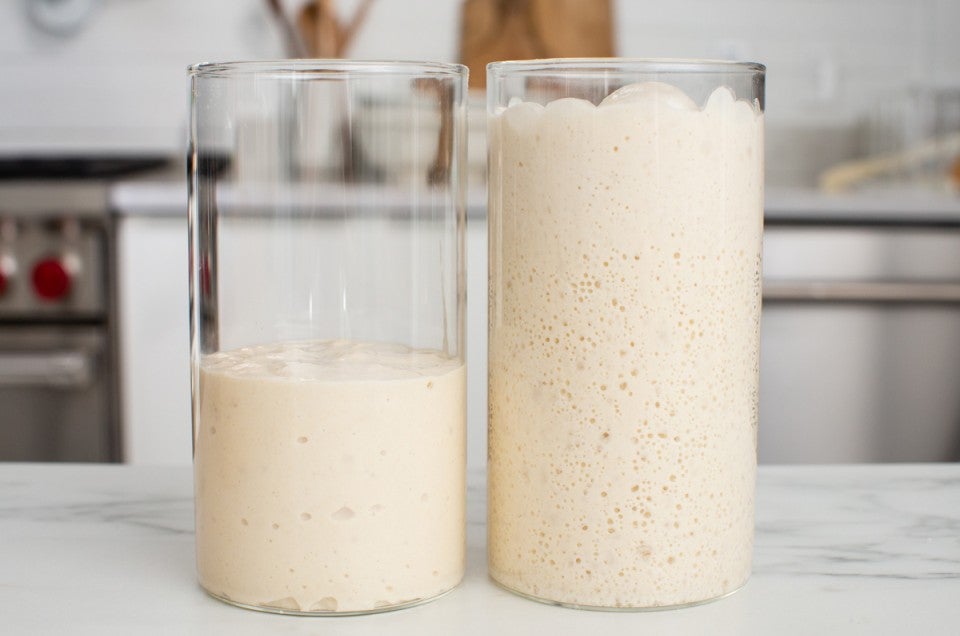


How do you know when your sourdough starter is ready to bake with? And what exactly does "ripe sourdough starter" mean?
We've answered hundreds of questions on this topic, but in this case, it seems some pictures could well be worth a few thousand words. Let's take a look. 
Your starter has been tucked safely in the refrigerator for ... awhile. Ten days, maybe longer. It's separated, with a few tiny bubbles in the bottom, and a layer of grayish-looking alcohol on top. This is the sight that generates a lot of phone calls to our hotline. Can this possibly be OK? Is it dead?
Despite its current uninspiring appearance, this starter is still capable of doing great things. Just not quite yet.
Stir everything back together (some people just pour off the top layer, which is OK, too), measure out 113g (1/2 cup) of starter and discard the rest, then feed the 113g starter with equal weights of flour (a scant 1 cup, 113g) and water (1/2 cup, 113g). Mix well, cover, and leave on the counter for 12 hours. Repeat the discard and feeding process every 12 hours, leaving the starter on the counter. After a few feedings, you'll see the starter becoming more and more active, doubling in size in a shorter time.
(Looking for ideas of what to do with that discarded starter? Visit this page to get a whole collection of recipe ideas.)
This is the same starter after a few days of the regular feedings described above. We stirred, discarded, and fed it with flour and water at 8 a.m. (2 hours ago). Now we're going to watch its development. See the number and size of the bubbles increasing?
The same starter at 1 p.m., 5 hours after feeding. It's beginning to expand, and has many more bubbles. If you watch it for a minute, you can see the bubbles forming and coming to the surface in slow motion. This is an active starter, growing and expanding, producing bubbles of carbon dioxide. But it's not yet ripe (at the top of its yeast and bacteria growth arc), nor at full strength for raising dough.
The same starter at 4 p.m., 8 hours after feeding. It's doubled in volume, and shows signs of just beginning to sag under its own weight. This is active starter that's also ripe, ready to be added to bread dough to perform its sourdough magic. After mixing it into dough, then some rising and folding, the dough can be shaped and refrigerated overnight to be baked tomorrow.
An important thing to note about measuring sourdough starter: The more bubbles in it, the less a cup of active, ripe starter weighs. Measuring by volume can mean you have more or less starter in your cup, depending on where it is on its growth curve. That's not a deal breaker for your recipe, but having a different amount of starter than called for may change the rising times and finished size of your loaf. To be sure you have the lifting power you need, measuring ripe starter by weight is always a better choice.
Once you gain confidence that your starter is vigorous, you can move its "get ready" feeding to the evening, knowing your starter will be ripe next morning to mix into your dough.
Your sourdough baking adventures await. We have lots of ideas (more than 150 recipes) to help you navigate this tasty and rewarding style of baking. Be sure to visit our sourdough guide for more in-depth information about creating, maintaining, and baking with sourdough.


November 25, 2020 at 11:59am
In reply to I've had a Sourdough starter… by Aditya (not verified)
Hi Aditya! It could just be that you have a really happy, active starter! Also, if your starter is in a nice cozy spot that will help it ripen faster, as will feeding your stater with whole wheat flour. If your starter looks like pictured here, we think it should be just fine to go ahead and use it. Happy baking!
September 3, 2020 at 8:40am
Hello,
I am having all sorts of trouble with sourdough breads. I never seem to get a good rise (dough doubling in volume) during my bulk fermentation, no matter the temperature or amount of time I use. I am wondering if perhaps my starter is never quite ready. I take the starter out of the fridge and feed it once a day for a few days until it is very bubbly within 12 hours of a feed. It usually doubles in height but I have never seen it grow to the extent you show in the above images. I am guessing I need to feed it more frequently and for longer to get it to “wake up” and be that active? I always use equal parts water and flower, and it’s always VERY liquid with almost no dough consistency to it. Do I need to use the bread flour for the feedings or can I use AP flour?
Thanks for any help you can give.
Tom
September 3, 2020 at 4:18pm
In reply to Hello, I am having all sorts… by Thomas McNally (not verified)
We're sorry to hear that you're having some trouble, Tom! We'd recommend feeding the starter a few more times before using it, as you suggested might the problem. We'd also recommend feeding it with some whole wheat flour a few times to give it a bit of a jump start. The consistency of the starter seems odd though, are you also discarding half of the starter at each feeding, using equal parts flour and water to the amount of starter? Discarding at maintenance feedings is important as this makes room for new yeast cells and good food-fermenting bacteria to grow. We hope this helps!
January 17, 2021 at 8:52pm
In reply to We're sorry to hear that you… by mmoss
I thought before feeding we discard all starter and keep just a 1/2 cup of starter then feed with a cup of King Arthur’s flour and a 1/2 cup of warm water.
Do we let it sit in a warm area before putting in the fridge and do we feed every 4 to 5 days? I’ve been feeding once a week (went 10 days once when on vacation) my baked goods always come out yummy.
The last two feedings I didn’t quite have a cup of discard for recipes. More like 3/4 cup and I’m wondering if I could have done something wrong.
After it sits in a warm cozy place after feeding I give it a stir and place it in the fridge.
I only bake once a week with the discard.
Also I have friends asking for discard.
Do I just give it to them.
Thank You! Mary
February 2, 2021 at 9:36am
In reply to I thought before feeding we… by Mary (not verified)
That's correct, Mary. You do want to discard before feeding, unless you're in the process of bulking up your starter to bake. The equal ratio of starter to flour to water is what you use when measuring in weight. Since flour is so much lighter than water, a cup of flour weighs roughly the same as a half cup of water, which is why your ratios seem different, even though you're following the exact same instructions. Different bakers have different preferences when it comes to feeding methods, but I've found that when I'm keeping my starter in the fridge rather than out on the counter, it does just fine being fed while still cool once a week. When I'm baking more often and keep it out on the countertop, I feed my starter twice a day. Starters are alive, and each one is different, so your starter and your neighbor's starter may have success with different methods.
January 2, 2021 at 6:47pm
In reply to Hello, I am having all sorts… by Thomas McNally (not verified)
It sounds to me like you're using equal parts of water and flour by volume (eg. 1/2 cup water and 1/2 cup flour). You should make sure that you're always measuring everything by weight. (eg. 120 gms. of water and 120 gm.s of flour). That should give you a 100% hydration level and a nice thick starter.
September 2, 2020 at 9:30pm
How long does the starter stay ripe? I have been doing twice a day discarding (after it doubled), feeding, etc. About 5 hours ago, my starter was doubled, but I was busy doing other things and am now ready to mix up some dough, but it has fallen back to a much smaller size. Can I still use it?
September 18, 2020 at 4:04pm
In reply to How long does the starter… by Matt (not verified)
Hi there, Matt! Once a starter reaches it's peak (doubled in size and very bubbly throughout) and starts to deflate it is still usable for leavening bread but the resulting loaf won't be as lofty as the yeast cells aren't as strong at this point. But, once the starter has collapsed back to its normal volume or is just about there it won't be very good for leavening bread. We hope this helps!
August 15, 2020 at 6:31am
Hi, please explain steps to follow after leaving dough in fridge for a slow rise over night.
Do I bring it back to room temperature & shape again or put straight into hot oven?
August 17, 2020 at 4:46pm
In reply to Hi, please explain steps to… by Anne (not verified)
Hi, Anne! This particular blog post is about sourdough starter, rather than dough. What you'll do when leaving dough to rise in the fridge depends on whether you're using the refrigerator for your first rise (in which case you'll remove the dough, shape your loaves, and allow them to rise a second time at room temperature before baking), or your second rise (in which case you'll simply pop them in the oven right away, provided they've risen sufficiently). It's likely that your recipe will have more specific instructions, so when in doubt, follow those. Happy baking!
Pagination